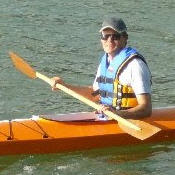I prepared the deck outside the living room with the main tools for the day's activities, marking out and cutting the lower hull panels.


I also took over the dining room with the plans, and took a copy of the offsets so I could have them outside without fear of the master plans blowing away or getting damaged.

The first job was to mark station lines at 305mm intervals along the plywood sheets before measuring the widths for each panel edge as per the offset table. I soon realised that the pine moulding I was intending to rule these lines with was far from straight.
Plan B was to take an old flat pack wardrobe door and cut a set square, roughly 400mm by 1300mm, thus saving a good few dollars at the big shed DIY store. It save a bit of time as well, I want to plan my buying with the tasks ahead in mind and not spend half the build time going back and forth to Mitre10 or some other supplier of hardware.


So, back to the main task. I got 1 version of the four main parts measured out and then I faired the edges to get smooth, curved lines. For this I used a 3m length of PVC electrical trunking cover, pierced with a bradawl and then pinned to the ply. I also pinned both boards to the deck, aligned down one edge with a taught string, and faired over the panels.

Cutting out the parts was going to be a problem. I only have one workbench and the 4mm ply is very floppy. I decided to nip out and buy 4 fence posts, 100mm square and 2.4m long. They'll be used in a later landscaping project so its not money wasted, and they're the ideal height to keep the jigsaw blade off the deck.
Each piece (bottom panel fore and aft sections and side panel fore and aft sections) was used as a template to draw and cut a duplicate. The matching pair of parts were then clamped together and put in the workbench. I used a block plane to trim the edges and get the two pieces as similar to each other as possible. The planing process also fairs out any kinks in the edges introduced by less than skillful handling of the jigsaw.


That was enough for day one of the build. I'll do nothing tomorrow because of the Land Rover Owners Club Auckland meeting, but on Tuesday I hope to 'get out' (proper boat-building term that) the transom, bulkheads and deck beams.



